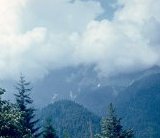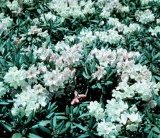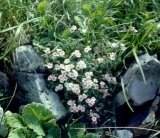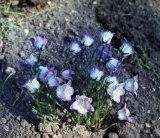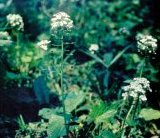 |
QUICK SEARCH
MO PROJECTS:
Africa
Asia/Pacific
Mesoamerica
North America
South America
General Taxonomy
Photo Essays
Training in Latin
America
MO RESEARCH:
Wm. L. Brown Center
Bryology
GIS
Graduate Studies
Research Experiences
for Undergraduates
Imaging Lab
Library
MBG Press
Publications
Climate Change
Catalog Fossil Plants
MO DATABASES:
W³MOST
Image Index
Rare Books
Angiosperm
Phylogeny
Res Botanica
All Databases
INFORMATION:
What's New?
People at MO
Visitor's Guide
Herbarium
Jobs & Fellowships
Symposium
Research Links
Site Map
Search
ORNAMENTAL PLANTS IN THEIR NATURAL HABITATSA. Georgia
The northern and southern parts of Colchis, Abkhazia and Adzharia respectively, form a floristic region of particular interest. The mild climate and constant humidity levels have favored a persistent native vegetation since the Pliocene. Therefore, Abkhazia, could be considered the most logical starting point for botanical expeditions in the Caucasus. One of the best choices for plant-hunting expeditions begins in Colchis.
The road north of the town of Sukhumi crosses a canyon-shaped gorge that
cuts through thick limestone. On each side the road slopes are covered
with oak forest (Quercus iberica). Secondary derivatives of this
forest are represented here by the so-called "shibliak," (deciduous
xerophyllous bush), which includes many Mediterranean hemixerophiles such
as Iberian barberry Berberis iberica, smoke tree Cotinus
The richest forests are those of the lower montane belt, the flora of which comprise about 60% of the entire flora of Abkhazia, and include 130 species that occur only in this forest community. Many forest herbs are endemic to the Caucasus, and in Abkhazia alone 60 to 80 endemic taxa have been reported (Kolakovsky, 1961; Adzinba, 1987). These occur at various altitudes but are most frequently found on rocks and rocky slopes. Some endemic species belong to primarily tropical families and reveal the ancient links of the Colchis flora. One example is yam Dioscorea caucasica of the mainly tropical family Dioscoreaceae, a beautiful liana with stems up to 5 m (16 ft) long, which grows on gravelly slopes. Other species are closely related to those inhabiting the mountains of Europe or eastern Asia. Many Abkhazian endemics are allied to other Caucasian species. The gentians Gentiana paradoxa, G. rhodocalyx and G. bzybica, which colonize rocks in the forest belt, are closely related to G. lagodechiana, a plant that occurs in Lagodechi (the central part of the Greater Caucasus) and, which is commonly cultivated in gardens. There are many herbaceous plants, that are valuable for gardening, e.g. St. Johnís Wort Hypericum xylosteifolium and a barrenwort Epimedium colchicum, both with yellow flowers. The route from Gudauta to the Kavakluk Hills runs over Quaternary and Tertiary terraces (Kolakovsky, 1974), on which tea, grape and tobacco are grown. In the oak forests of the Kavakluk Hills there is a shrub layer of tree heath Erica arborea, a xerophilous species typical of the western Mediterranean. The abundance of Mediterranean hemixerophilous species is characteristic of a floristic complex particular to the Black Sea coast, the "Pitsunda Grove". As a rule, the Pitsunda pine, Pinus pityusa, like many coastal pines grows on dry, stony, mainly calcareous slopes. Here one sees the wonderful coast lily Pancratium maritimum, growing under the forest canopy, and the candelabra-shaped Euphorbia paralias. In the pine groves there is a well-developed low shrub layer of Cistus tauricus and Ruscus aculeatus. Here a particularly interesting find is Cytinus ruber of the mainly tropical family Rafflesiaceae as a parasite on the roots of Cistus tauricus. Only three species of the Raflesiaceae family grow within the entire Holarctic (the second in North America, and the third one in southwestern Asia). The floristic richness of the rocky forest complex (Dolukhanov, 1989) is well represented in the gorge of the Bzyb River near Pitsunda. Such gorges form the core of the Colchis refuge (Adzinba, 1987) and account for the great diversity of habitats in this region. The road from Pitsunda to the east leads to Lake Ritsa, a well-known tourist site. The upper Bzyb valley is a canyon with steep sides to 300 m (987 ft) or more in height. On its sheer rocky slopes one can see numerous herbaceous plants, such as bellflower Campanula mirabilis considered the "Queen of the Abkhazian flora" by A. Albov, a specialist in the Caucasian flora. The overhanging masses of blue flowers adorn the rocks all along the gorge. Each plant can produce some 100 flowers during its flowering period from June to August. Several other species of bellflower occur here, some of which were unknown until recently to both gardeners and botanists. Campanula paradoxa, for example, was not described until recently (Kolakovsky, 1976). It grows on cliffs around a small lake along the road to Ritza and forms a rosette of large leaves with lateral shoots producing inflorescences of white flowers. This Campanula species could be an attractive garden plant as well as other local bellflowers (C. albovii and C. dzyschrica). A pale-blue columbine, Aquilegia gegica and a buttercup, Ranunculus suukensis, with bright large flowers (up to 2,5 cm in diam.) are also little known. The beautiful endemic here Woronowia speciosa, a member of the rose family, is closely related to Geum but differs in its larger size (up to 80 cm/31"), and its large leaves (25 cm long). Lake Ritza lies on elevation of 950 m (3,110 ft) and is up to 170 m (550 ft) deep. It is considered to be of tectonic origin and perhaps was formed as a result of a gigantic landslide (Kolakovsky, 1974). From this lake flows the Yupshara river. The Yupshara gorge is a magnificent natural canyon cutting through thick limestone strata. On its cliffs and other rocky exposures grow many attractive plants, among them ornamental maples with dark green five-lobed leaves Acer sosnowskyi, beautiful silvery-leaved herbs (Amphoricarpos elegans, Centaurea abchasica, C. barbeyi) of the daisy family. Pink blossoms of carnation Dianthus imereticus, white-flowered perennial navelwort Omphalodes kusnetzovii and snow-in-summer Cerastium ponticum are suitable to rock and gravel in which they often choose to grow. In winter and early spring, one can see an abundance of a delicate sowbread Cyclamen abchasicum; in mid-spring grape hyacinth Muscari dolichanthum and star of Bethlehem Ornithogalum arcuatum catch the eye. At forest margins, on damp sunlit plots, a special vegetation type known as tall herbs has developed (Gagnidze, 1974). Common species include cow-parsnip (Heracleum), the tallest of which is Heracleum mantegazzianum (up to 4 m/13 ft). The largest Caucasian lily,
In the wide part of the Bzyb valley a large Agricaltural Experimental Station with plants introduced from all over the world attracts attention. Gems in its collections are the valuable coniferous coastal redwood Sequoia sempervirens and the deodar Cedrus deodara. These 50-year old redwoods are now about 25 m (80 ft) tall. Both species do very well in this climate and have a great horticultural potential. Excursions in southern Colchis (Adzharia) should start from the coastal city of Batumi, the capital of the Republic, and follow one of two interesting routes. The first route leads to Mt. Mtirala and passes an area of Colchis forest that has been well preserved. Mt. Mtirala ("the weeping mountain") has been so named by the native people because its summit is almost always covered with clouds. It belongs to the Adzharo-Imeretinskiy range and precipitation here varies from 3,980 to 4,500 mm (156-177") per year, equivalent to that of a tropical rain forest. This is why the vegetation is very lush. The road to Mtirala follows gentle sloping spurs along the narrow gorge of the Korolitskali River. The broad-leaved forest growing here consists of trees such as sweet chestnut Castanea sativa, a lime Tilia begoniifolia [=T. caucasica] and persimmon Diospyros lotus with a dense understory of the fern Pteridium tauricum, pokeweed Phytolacca americana, an escaped American garden herb, herbaceous lianas Smilax excelsa and Caucasian yam Dioscorea caucasica, as well as numerous shrubs. Above 600-800 m (1,960-2,600 ft), one can see the white-flowered Rhododendron ungernii, with oriental spruce Picea orientalis appearing around 1,000 m (3,200 ft). Here oriental blueberry Vaccinium arctostaphylos, evergreen shrub Viburnum orientale and the deciduous Rhododendron luteum also thrive. The ground is covered by various ferns (Dryopteris pseudomas, D. carthusiana, Oreopteris limbosperma, Polystichum aculeatum, P. setiferum, Phyllitis scolopendrium, Blechnum spicant). Where the understory is less dense, the composition of the herbaceous cover is richer. Many species bloom before tree foliage of the canopy shades the ground layer. Among such plants are white butterbur Petasites albus whose inflorescences appear in early spring, a barrenwort Epimedium pubigerum, a yellow-flowered primrose Primula sibthorpii and a pink-flowered one Primula megaseifolia. There are many tall herbs: goatsbeard Aruncus vulgaris, bittercress Cardamine, thistle Cirsium hypoleucum, milky bellflower Gadellia lactiflora, yellow peony Paeonia macrophylla, Telekia speciosa and a valerian Valeriana alliariifolia with large simple cordate leaves. Herbaceous cover on steep slopes may be sparse and impoverished in species number. In the upper reaches of rivers flowing from Mt. Mtirala, two very interesting woody species appear: a shrubby oak Quercus pontica, with large toothed oval leaves up to 25-35 cm (9.8-13.8") long and 12-15 cm (4.2-5.9") wide, and a shrubby birch Betula medwediewii with large corrugated leaves to 8-10 cm (3.1-3.9") that turn bright yellow in autumn. These species are endemics to Colchis and Lazistan, two botanically rich regions in the Caucasus. The second route is about 50 km (30 miles) long and leads from Batumi to the Kintrishi Gorge. It runs east of the town of Kobuleti rising from sea level to 1,000 m (3,200 ft). The flora of the Kintrishi Gorge includes 1,040 species belonging to 460 genera, 220 of which are considered relictual species and another 93 endemic to the Caucasus (Dmitrieva, 1960). The road from Kobuleti follows the maritime lowlands where the natural vegetation has been greatly altered by agriculture. In some places one can see small pockets of the royal fern Osmunda regalis mixed with Hibiscus ponticus, a shrub closely related to the Hibiscus species of the Mediterranean region, as well as summer snowflake Leucojum aestivum and a raspberry Rubus hirtus. Mixed forest has persisted on slopes from 600 to 1,200 m (1,960-3,930 ft). This is characterized by vigorous development of a broad-leaved tree story of beech Fagus orientalis, chestnut Castanea sativa and lime Tilia begoniifolia. Here one sees many evergreen shrubs such as Rhododendron ponticum, R. ungernii, Laurocerasus officinialis [=Prunus laurocerasus], holly Ilex imerethica and also lianas, ivy Hedera colchica, honeysuckle Lonicera caprifolium, old manís beard Clematis vitalba and silk vine Periploca graeca. The Colchis forest here is not particularly rich in herbaceous species, largely because of the evergreen shrubby cover under which only shade-tolerant herbs can grow. Among such herbs are birthwort Aristolochia pontica, sowbread Cyclamen adzharicum, navelwort Omphalodes cappadocica, comfrey Symphytum grandiflorum and Campanula makaschvilii, all of which are interspersed with ferns. The narrow gorges of the tributaries include rare fern species such as Hymenophyllum tunbrigense. The summit of Mt. Elias-Tsikhe is crowned by the ruins of an ancient fortress and from there a magnificent view of the Colchis can be seen. Plants with ornamental potential here include a lily Lilium szovitsianum related to the familiar L. monadelphum but differing in having vermilion red pollen grains and Peucedanum ruthenicum, almost unknown in North American gardens but cultivated in Europe. A rockfoil Saxifraga repanda with its clouds of white flowers also grow there. At heights of 550 to 1,120 meters (1,800-3,600 ft), chestnut forms almost pure forest stands. Much of the wild Colchis flora can be seen in Batumi itself, especially in the Batumi Botanical Garden, founded in 1912 by the famous Russian botanist A. N. Krasnov. The garden features a park with introduced plants as well as a Colchic forest reserve. From the coastal cities (Sukhumi or Batumi), an excursion by air to the city of Tbilisi, the capital of Georgia, offers a general view of the Central Caucasus. A flight along the Greater Caucasian Range reveals spectacular ridges and breath-taking scenery. Tbilisi is situated in the lowlands at 400-500 m (1,300-1,630 ft) along the Kura River and is surrounded by semi-desert, steppe and forest. From Tbilisi, the well-travelled Georgian Military Road leads northward across the Greater Caucasus Range to Vladikavkaz (Ordzhonikidze during the Soviet period). This road is mentioned in old Georgian chronicles and the ancient manuscripts of Roman and Arab historians. The first settlement along the Georgian Military Road is Mtskheta, the former capital of Georgia, where the road crosses the Aragvi River valley and the Sagurami Ridge. This forested ridge is covered with oaks Quercus iberica and Q. pedunculiflora and oriental beech Fagus orientalis. The foothills of the Alev Ridge rise above the Mukhran Plain where the ornamental herbaceous paeony Paeonia tenuifolia and a skullcap Scutellaria orientalis are probably the most familiar plants. Paeonia caucasica adorns the oak-hornbeam woodland floor with its deep red flowers. Broad-leaved forest covers the Bazaleti Plateau, and the road begins gradually to rise until it enters the Greater Caucasus near Zhinvali. The settlement of Mleta is situated at 1,200 m (3,400 ft). Here, roadside slopes are covered with the dark pink roses Rosa mollis and R. marshalliana. Herbaceous communities in the subalpine grasslands, where the most interesting ornamentals occur include a bellflower Campanula trautvetteri with dark violet flowers in dense sessile clusters, a betony Stachys macrantha [=Betonica macrantha] with violet flowers in dense whorls, a tall cornflower Centaurea salicifolia with white tomentose leaves and the dwarf shrub Daphne glomerata, with pink-white flowers that are deliciously fragrant yet dangerously poisonous. On rocky cliffs along the roadside near Gudauri, many of the interesting and unusual plants are endemic to the Greater Caucasus. The most distinctive of these are a very dainty bellflower Campanula hypopolia with silvery-haired leaves and elongated blue flowers, the handsome Hedysarum caucasicum with dark purple flowers and Astragalus kazbeki, with its white-violet flowers. The Krestoviy Pass (Krestovyi Pereval) lies at 2,395 m (7,800 ft),
where there is a gradual transition from subalpine meadow to lower alpine
vegetation. Herds of sheep and goats are driven through the pass from
winter to summer pastures, and cause serious damage to the vegetation.
The secondary vegetation cover is also very sparse, with solitary inedible
plants such as false hellebore Veratrum lobelianum with stems
1.5-2 m (5-6.5 ft) high and a spiny thistle Cirsium pugnax. A
few representatives of lady's mantle (Alchemilla), Sibbaldia
parviflora and the widespread grass Nardus stricta occurs
here. In the lowlands, a primrose Primula auriculata, starry
grasswort Cerastium arvense and a bellflower Campanula
The village of Kazbegi is located at 1,760 m (5,774 ft) at the foot of Mt. Kuro (4,090 m/13,418 ft) and faces the left bank of the Terek River. Across the river, the towering snow-capped peak of Mt. Kazbegi (5,047 m/16,550 ft) resembles a sugar loaf. A number of rare and endemic plants, such as woodruff Asperula albovii, rockfoil or saxifrage Saxifraga cartilaginea and houseleek Sempervivum pumilum are found in the Kazbegi intermontane depression, growing best along the rocky banks of the Terek. An unusual pasque flower Pulsatilla violacea, with somewhat drooping violet flowers, and a mat-forming speedwell Veronica gentianoides are conspicuous representatives of the alpine and subalpine floras. An early immigrant, the naturalized North American pineapple weed, Lepidotheca suaveolens [=Matricaria matricarioides], flourishes among common Caucasian plants along the road leading to the Gergeti glacier. Along with the grasses, many other species are seen at their best in the subalpine grasslands, including some ornamentals, such as anemone Anemonastrum fasciculatum related to A. narcissiflorum, Anthyllis macrocephala (a tall biennial of the pea family), masterwort Astrantia biebersteinii, elecampane Inula orientalis, painted daisy Pyrethrum carneum [=Tanacetum coccineum subsp. carneum] and pincushion-flower or scabious Scabiosa caucasica. Steeper slopes and rocky escarpments are covered by a small bellflower Campanula bellidifolia and a white carnation Dianthus cretaceus among others. A dark violet bellflower Campanula collina and a mat-forming milk vetch Astragalus captiosus are usually present on gravelly substrates, while Swertia iberica, an endemic of the Gentianaceae, and Dolichorrhiza renifolia (Asteraceae) are associated with damp habitats. The tall lily Lilium monadelphum and the very beautiful columbine Aquilegia olympica are common in birch woodlands. Around the pass (2,900 m/9,510 ft) and below the snow line, the moraines are covered with cushions formed by various sandworts, e.g., Minuartia imbricata and M. aizoides, while the rosettes of a primrose Primula bayernii can be seen perched among the stones. The unstable scree is adorned by the lilac-blue flowers of Corydalis emanuelii and a tiny speedwell Veronica minuta. The gorge of the River Terek narrows near Kazbegi, and across the Gveleti bridge, the road enters the Dariali Gorge, with rocky cliffs almost closing over it. The yellow, cushion-forming rockfoil or saxifrage Saxifraga juniperifolia and the violet-flowered, rosette-forming primrose Primula darialica favour rocky crevices. A bellflower Campanula sarmatica brightens rocky cliffs with its large pale blue flowers. From the Dariali Gorge, the Terek enters the Chmi intermontane depression and crosses the Rocky Ridge. Investigation of the flora of the Greater Caucasus as a whole has been closely correlated with vegetation studies of the area traversed by the Georgian Military Road, with many popular ornamental species first reported from this area. For example, Baron von Bieberstein was the first to describe Primula amoena from the vicinity of Kazbegi and Delphinium speciosum from Kaishauri. The southern slopes of the Great Caucasian Range in eastern Georgia also have a rich and varied vegetation. The densely populated Kakhetia is one of the most beautiful areas of Georgia. Natural vegetation persists here mostly in the Lagodekhi Reserve, covering 17,000 hectares (about 42,000 acres), which extends from the foot of the mountains to ridge tops (3,000-3,500 m/9,840-11,480 ft). Here the southern slope of the Greater Caucasus is about 15-20 km (9.3-12.5 mi) wide and deeply divided by flanking spurs. Field trips through the Lagodekhi Reserve may follow several paths. One of the upland roads begins near the Reserve office at 500-600 m (1,640-1,970 ft). At first, the road winds beneath a tall beech-hornbeam forest mixed with other woody plants, such as maple (Acer), lime Tilia begoniifolia, wing nut Pterocarya pterocarpa and alder Alnus barbata along watercourses. Oak Quercus pedunculiflora occurs sporadically. In dry places hornbeam Carpinus orientalis, hazelnut Corylus avellana and Cornelian cherry Cornus mas are present in the undergrowth. Dominant grassy components are
The slopes of Mt. Khochal are magnificent in spring, and are adorned by a snowdrop Galanthus lagodechianus, and also by Corydalis caucasica and Cephalanthera longifolia, which are among the earliest rare plants to flower. The yellow-flowered paeony Paeonia mlokosewitschii, which blooms in spring and early summer, can be successfully cultivated and will give rise to a number of more decorative cultivars. Furthermore, endemics such as Gymnospermium smirnowii [=Leontice smirnovii], Campanula doluchanovii, Rubus kudagorensis and R. kacheticus that were first reported from Lagodekhi Reserve, are also promising plants. At the foot of the ridge, the broad, once forested Alazanskaya Valley (Alazanskaya Dolina) extends along the lower boundary of the reserve; it is now occupied by vineyards, orchards and industrial and agricultural crops for commercial harvest. |
|||||
| ORNAMENTAL PLANTS FROM RUSSIA |
© 1995-2025 Missouri Botanical Garden, All Rights Reserved
4344 Shaw Blvd.
St. Louis, MO 63110
(314) 577-5100
Technical Support
